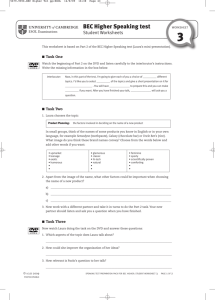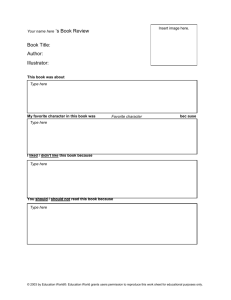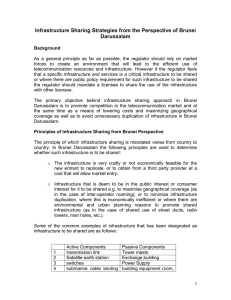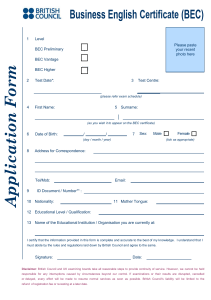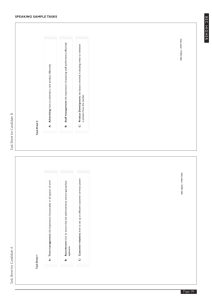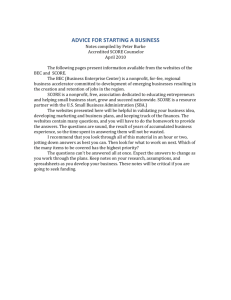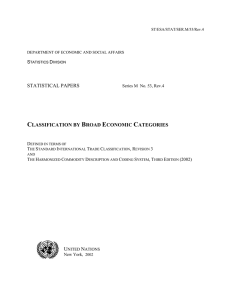RIETI-TID 2014 (RIETI Trade Industry Database)
advertisement
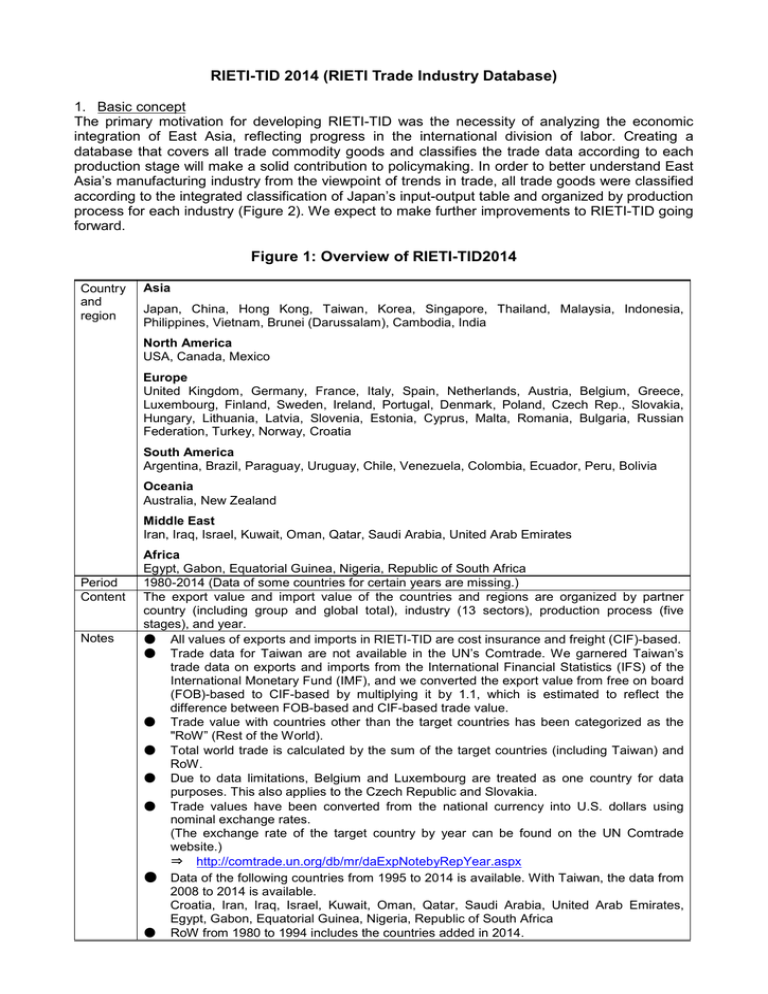
RIETI-TID 2014 (RIETI Trade Industry Database) 1. Basic concept The primary motivation for developing RIETI-TID was the necessity of analyzing the economic integration of East Asia, reflecting progress in the international division of labor. Creating a database that covers all trade commodity goods and classifies the trade data according to each production stage will make a solid contribution to policymaking. In order to better understand East Asia’s manufacturing industry from the viewpoint of trends in trade, all trade goods were classified according to the integrated classification of Japan’s input-output table and organized by production process for each industry (Figure 2). We expect to make further improvements to RIETI-TID going forward. Figure 1: Overview of RIETI-TID2014 Country and region Asia Japan, China, Hong Kong, Taiwan, Korea, Singapore, Thailand, Malaysia, Indonesia, Philippines, Vietnam, Brunei (Darussalam), Cambodia, India North America USA, Canada, Mexico Europe United Kingdom, Germany, France, Italy, Spain, Netherlands, Austria, Belgium, Greece, Luxembourg, Finland, Sweden, Ireland, Portugal, Denmark, Poland, Czech Rep., Slovakia, Hungary, Lithuania, Latvia, Slovenia, Estonia, Cyprus, Malta, Romania, Bulgaria, Russian Federation, Turkey, Norway, Croatia South America Argentina, Brazil, Paraguay, Uruguay, Chile, Venezuela, Colombia, Ecuador, Peru, Bolivia Oceania Australia, New Zealand Middle East Iran, Iraq, Israel, Kuwait, Oman, Qatar, Saudi Arabia, United Arab Emirates Period Content Notes Africa Egypt, Gabon, Equatorial Guinea, Nigeria, Republic of South Africa 1980-2014 (Data of some countries for certain years are missing.) The export value and import value of the countries and regions are organized by partner country (including group and global total), industry (13 sectors), production process (five stages), and year. ● All values of exports and imports in RIETI-TID are cost insurance and freight (CIF)-based. ● Trade data for Taiwan are not available in the UN’s Comtrade. We garnered Taiwan’s trade data on exports and imports from the International Financial Statistics (IFS) of the International Monetary Fund (IMF), and we converted the export value from free on board (FOB)-based to CIF-based by multiplying it by 1.1, which is estimated to reflect the difference between FOB-based and CIF-based trade value. ● Trade value with countries other than the target countries has been categorized as the "RoW” (Rest of the World). ● Total world trade is calculated by the sum of the target countries (including Taiwan) and RoW. ● Due to data limitations, Belgium and Luxembourg are treated as one country for data purposes. This also applies to the Czech Republic and Slovakia. ● Trade values have been converted from the national currency into U.S. dollars using nominal exchange rates. (The exchange rate of the target country by year can be found on the UN Comtrade website.) ⇒ http://comtrade.un.org/db/mr/daExpNotebyRepYear.aspx ● Data of the following countries from 1995 to 2014 is available. With Taiwan, the data from 2008 to 2014 is available. Croatia, Iran, Iraq, Israel, Kuwait, Oman, Qatar, Saudi Arabia, United Arab Emirates, Egypt, Gabon, Equatorial Guinea, Nigeria, Republic of South Africa ● RoW from 1980 to 1994 includes the countries added in 2014. Figure 2: Structure of Trade Industry Classification Table 2. Industry classification: In order to understand the trade structures whereby the production process has been divided, merely grouping the trade goods by production stage is insufficient. Classification for each industry is also required since the extent of division and the economic characteristics of production for all goods are diverse. Industries were organized into 13 sectors based on the classification of the manufacturing businesses, including “Agriculture, forestry and fisheries,” and “Mining” in the integrated classification (32 sectors) of Japan’s input-output table (Figure 3). The classification is detailed below to reflect the progress toward the inter-process division of labor in East Asia more accurately. A) “Agriculture, forestry and fisheries” and “Mining,” which represent the production of primary goods and materials, are not classified as independent industries as they are in the Japanese I-O table, but are organized as industries upstream of each respective manufacturing industry. More specifically, “Food” and “Pulp, paper and wood products” are categorized as “products related to agriculture, forestry and fishery.” Also, “Chemical products,” “Petroleum and coal products,” “Ceramic and cement products,” “Iron and steel,” “Nonferrous metal,” and “Metal products” are categorized as “products related to mining.” B) “Nonferrous metal” and “Metal products” were combined into one category as their production processes have numerous similarities. In addition, “Iron and steel” is also included in the same industry as it can only be categorized as “Processed goods” in the Broad Economic Categories (BEC) classification. C) “Electrical machinery” was divided into “Electrical machinery” and “Home electronics, appliances,” considering the circumstances of the inter-process division of labor in East Asia. D) “Other manufacturing industrial products” was renamed as “Toys and sundries” to show the specific goods in this industry. Although plastics are classified in “Other manufacturing products” in the I-O table, they are included in “Chemical products” and not in “Toys and sundries,” in view of the production process. Figure 3: Trade Industry Classification Table Production stage Industry Intermediate goods Primary Processed goods Parts & Components ● ● ● ● ● ● ● ● ● ● ● ● ● ● ● ● ● 01 Food and related agriculture, forestry and fisheries 02 Textile products Pulp, paper and wood products (including rubber, leather 03 and oil) and related agriculture, forestry and fisheries 04 Chemical products (including plastics) 05 Petroleum and coal products, related mining 06 Ceramic and cement products, related mining 07 08 09 10 11 12 13 Iron and steel, nonferrous metal and metal products, related mining General machinery Electrical machinery Home electronics, appliances Transportation equipment Precision machinery Toys and sundries ● ● ● Final goods Capital goods Consumption goods ● ● ● ● ● ● ● ● ● ● ● ● ● ● ● ● ● ● ● ● ● ● ● ● ● ● ● ● Source : Classification by Broad Economic Categories (BEC), UN Statistics Division 3.Classification of trade goods by production stage: We employ the BEC classification system in order to classify all of the trade goods by production stage. According to the UN Statistics Division’s website, “BEC was developed in such a way as to provide elements which enable the construction of aggregates approximately comparable to those for the three basic classes of goods in the 1968 System of National Account (SNA). 1 A number of sub-categories were established to supplement these main categories. The sub-categories reflect the various end-uses of commodities.” Based on the classification of BEC, we organized trade goods into three categories (five subcategories) which are further classified according to the SNA’s standard. Figure 4 shows the profile of the classification. Below we briefly describe the classification of each category. 2 “Primary goods” are materials to be used for food and beverages and in industrial supplies. These goods mainly turn into “Intermediate goods” through the first stage of the manufacturing process in the respective industry. Defined as materials for intermediate input, primary goods cover only goods for industrial use, excluding those used in household consumption. This is due to the main objective of the grouping seen in Figure 4, which is to distinguish trade goods according to the production stage. “Intermediate goods” are trade goods that represent the intermediate input along the path toward becoming the final product. These goods are manufactured goods (processed or assembled) that are produced from primary goods but still are not yet final products. This category has two 1 The BEC classification corresponds to the classification based on the “use of basic products” in the 1968 SNA (Intermediate Consumption, Final Consumption and Gross Capital Formation). 2 Please refer to “China’s Integration in Asian Production Networks and its Implications,” (F. Lemoine. et. al., (2004)) for the classification by production stage. subcategories, “Processed goods” and “Parts & Components,” each respectively defined on the basis of BEC. These two subcategories have been created since the goods in each subcategory are considered to have undergone different extents of manufacturing, experienced different production processes, and tend to have different shares in specific industries. “Final goods” is defined here as goods used by the producer (as the intermediate input) and goods consumed by households and the government. The two types of goods in this category are “Capital goods” and “Consumption goods,” which are listed as separate categories under SNA since this standard classifies commodity goods according to the main user. They both fall within the one category of “Final goods” because, under the Trade Industry Classification, the primary focus is on the stages of the manufacturing process, not on the end-users of the goods. Even so, this classification is still considered convenient for subsequent studies such as analyzing the relations among domestic production, consumption, and trade, as the classification is associated with SNA and can identify the end-users. Figure 3 shows the structure of Trade Industry Classification Table. Figure 4: Classification table of trade goods by production stage Category Sub-category BEC code BEC Title Primary goods 111 Food and beverages, primary, mainly for industry Intermediate goods 21 Industrial supplies, n.e.s., primary 31 Fuels and lubricants, primary 121 Food and beverages, processed, mainly for industry Processed goods Parts & Components Final goods Capital goods Consumption goods 22 32 42 53 41 521 Industrial supplies, n.e.s., processed Fuels and lubricants, processed Parts and accessories of capital goods, except transport equipment Parts and accessories of transport equipment Capital goods, except transport equipment Other industrial transport equipment 112 122 51 522 61 62 63 Food and beverages, primary, mainly for household consumption Food and beverages, processed, mainly for household consumption Passenger motor cars Other non-industrial transport equipment Durable consumer goods n.e.s. Semi-durable consumer goods n.e.s. Non-durable consumer goods n.e.s. 1. This classification table represents the traded goods in BEC categories that are linked to the criteria of System of National Account (SNA) and classified by process stage (cf. the research results of CEP II). Since SNA divides the data by user (producer, household, etc.), “capital goods (capital formation)” and “consumption goods (final consumption)” are separated; however, “capital goods” are considered part of “final goods” in this case, based on the idea that international trade is organized by stage of production process. 2. For BEC code 32, 321-motor spirits may be divided into “household consumption” and “use of other industrial transport equipment”; however, this distinction is not made in this case. 4. Data Source: RIETI-TID 2014 used the Standard International Trade Classification (SITC) data of the UN Comtrade. Although the classification is a bit rougher, 3 it reflects the raw materials used in production, production stages, product descriptions, technological progress, and other factors as its characteristics, which is appropriate for reflecting the inter-process division of labor. 4 5.How to search the database: 3 While the Harmonized Commodity Description and Coding System (HS) uses a six-digit classification, SITC used up to a five-digit classification. 4 The characteristics of the SITC classification are described on the UN website as follows: “The commodity groupings of SITC reflect (a) the materials used in production, (b) the processing stage, (c) market practices and uses of the products, (d) the importance of the commodities in terms of world trade, and (e) technological changes.” The characteristics of the HS classification are as follows: “The HS contributes to the harmonization of customs and trade procedures and the non-documentary trade data interchange in connection with such procedures, thus reducing the costs related to international trade” (World Customs Organization). “In the HS, goods are classified by what they are, and not according to their stage of fabrication, their use, or origin. The Harmonized System nomenclature is logically structured by economic activity or component material” (University of British Columbia). HS is commonly used for economic analysis because it comprises about 5,000 commodity groups (each identified by a six digit code), greatly exceeding the SITC’s approximately 3,100 groups. RIETI-TID data retrieval is performed in the steps reflected in Figure 5. Figure 5: How to search the database ① Select the exporting country or area. ② Select the importing country or area. ③Select the industry. ④Select the production stage (3 or 5 category). ⑤Select the period. ⑥ Finally, search results are displayed by clicking the “search” button. The unit of trade value is displayed in U.S. dollar terms. <Share> To check the trade share by country, group, or industry, please click the “share” button. For example, if you are examining the proportion of exports to the U.S. (out of Japan’s total exports), please select “World Total” of the importer. When the “Share” button is clicked, the value of the selected “Denominator” is displayed. [Share] = [Trade Value] / [Denominator] Depending on the conditions entered, the share may exceed 100%. ※ Even in the case the "Denominator" is zero, "1" is displayed for convenience sake in deriving the "Share." ※Country groups are defined as follows. Figure 6: Definitions of country groups in the database Group EAST ASIA NAFTA MERCOSUR EU15 EU28 ASEAN4 ASEAN ASEAN +3 ASEAN +6 Japan, China, and Korea TPP Country Japan, China, Hong Kong, Korea, Taiwan, Singapore, Indonesia, Malaysia, Philippines, Thailand, Brunei (Darussalam), Cambodia, Vietnam USA, Canada, Mexico Argentina, Brazil, Paraguay, Uruguay, Venezuela United Kingdom, France, Germany, Italy, Austria, Belgium-Luxembourg, Denmark, Finland, Greece, Ireland, Netherlands, Portugal, Spain, Sweden United Kingdom, France, Germany, Italy, Austria, Belgium-Luxembourg, Denmark, Finland, Greece, Ireland, Netherlands, Portugal, Spain, Sweden, Bulgaria, Cyprus, Czechoslovakia, Estonia, Hungary, Latvia, Lithuania, Malta, Poland, Romania, Slovenia, Croatia Indonesia, Malaysia, Philippines, Thailand Indonesia, Malaysia, Philippines, Singapore, Thailand, Brunei (Darussalam), Cambodia, Vietnam Indonesia, Malaysia, Philippines, Singapore, Thailand, Brunei (Darussalam), Cambodia, Vietnam, Japan, China, Korea Australia, China, India, Indonesia, Japan, Malaysia, Philippines, Korea, Singapore, Thailand, Brunei (Darussalam), Cambodia, New Zealand, Vietnam Japan, China, Korea Singapore, Brunei (Darussalam), Chile, New Zealand, USA, Australia, Vietnam, Peru, Malaysia, Colombia, Canada, Japan BRICS Brazil, Russian Federation, India, China, Republic of South Africa ※"Not ASEAN" and "Not EU" denotes a country other than the above countries. ※If selecting Exporter "EAST ASIA" or Importer "Japan," the Trade Value is displayed: Exporter denotes East Asia countries (except for Japan); Importer denotes Japan. ※Import data for Cambodia, Equatorial Guinea, Venezuela, Gabon, Iran, Iraq, and Saudi Arabia in 2014 are unpublished and thus not reflected.



